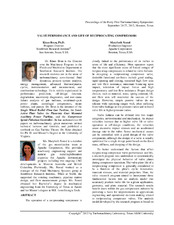| dc.description.abstract | The operation of a reciprocating compressor is closely linked to the performance of its valves in terms of life and efficiency. Most operators report that the most significant cause of forced outages of reciprocating compressors is related to valve failures. In designing a reciprocating compressor valve, desirable functional attributes include good sealing, rapid opening and closing, sustained high flow area and low flow resistance, minimum bouncing upon impact, toleration of impact forces and high temperatures, and low flow resistance. Proper design choices, such as material, mass, spring constant, lift, and flow area will maximize the success of the design. However, simple passive valves do not tolerate wide operating ranges well, often suffering from valve leakage at low pressure ratios and reduced valve life at higher pressure ratios. Valve failures can be divided into two major categories, environmental and mechanical. As impact velocities increase due to higher valve lift or valve operation at off-design conditions, the velocities cause excessive impact stresses and an accelerated damage rate to the valve. Some mechanical causes can be controlled with a good design of the valve components, although the design of a valve is usually optimized for a single design point based on the fixed mass, stiffness, and damping of the design. To better understand the factors that affect reciprocating compressor valve performance and life, a research program was undertaken to systematically investigate the physical behavior of valve plates during compressor operation. The valve plate life of a reciprocating compressor is generally considered to be a function of the plate’s cyclic kinematics, transient stresses, and material properties. Thus, the valve research program aimed to incorporate these fundamental factors into an analysis model that accurately predicts valve life for a given application, geometry, and plate material. The research results benefit users within the gas compression industry by providing a basis for improvements in applications engineering and operational decision-making related to reciprocating compressor valves. The analysis model developed by the research program is based on results from plate single impact strain gauge tests, dynamic finite element (FE) calculations, optical valve plate 3-D motion measurements, and material high cycle fatigue testing. This paper describes the research program, experimental and analytical results, and the valve life and performance prediction tool that was developed along with recent research findings to advance passive valve technology. | en |


